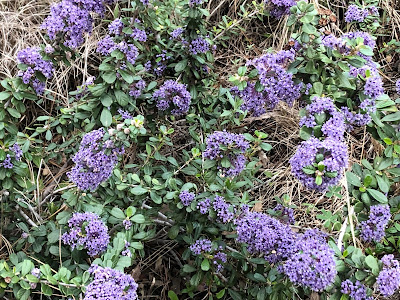
Take virtual visits to native plant gardens April 17-24
California native plants have been here all along, boosting native wildlife and helping keep our climate healthy. We can return the favor by planting and enjoying natives in our gardens and protecting them in our parks and wildlands.
Starting Saturday, the state celebrates California Native Plants Week, and native plants get a special boost from, not surprisingly, the California Native Plant Society. Their one-minute kickoff video can be viewed here .
CNPS is promoting the week with the theme "Grow CARE Everywhere." The acronym stands for a four-branch approach to enjoying and preserving California natives:
-- Cultivate. Nursery partners and local CNPS chapters are offering special events, plant sales and discounts .
-- Act. Dudleya plants are among natives in danger -- in this case, from poaching by people who want to cash in on the succulent trend. CNPS notes that plant poaching is a serious problem that puts dozens of species at risk every year. The group is supporting Assembly Bill 223 to make Dudley poaching illegal. Read more here and while you're there check out the adorable Dudleya GIFs associated with the various chapters of CNPS.
-- Restore. Local chapters work to promote and protect native plants in their areas. CNPS has 35 local chapters across the state; information on the Sacramento Valley Chapter is here .
-- Enjoy. This is the one we can do from anywhere that has Wifi: Take a new 360-degree virtual tour of native gardens every day of the celebration week. Get inspired by visiting real-world urban and mountain gardens, botanic gardens, parks and wildlands all over the state. See CNPS' special page for the week for all the links and details.

|
|
This beautiful specimen of ceanothus grows in the UC Davis
Arboretum and Public Garden, which has many natives.
|
Natives already know how to cope with the California climate -- including our drought years. And you'll be helping insects and birds, too, which depend heavily on native plants.
The nurseries in the area are increasingly tuned into the benefits of native plants, so don't be afraid to ask about the ones they carry. The UC Davis Arboretum sales are a great source for natives, too. Finally, check out this list at Calscape for ideas of native plants to grow.
Comments
0 comments have been posted.Sacramento Digs Gardening to your inbox.
Food in My Back Yard Series
May 6: Maintain soil moisture with mulch for garden success
April 29: What's (already) wrong with my tomato plants?
April 22: Should you stock up on fertilizer? (Yes!)
April 15: Grow culinary herbs in containers
April 8: When to plant summer vegetables
April 1: Don't be fooled by these garden myths
March 25: Fertilizer tips: How to 'feed' your vegetables for healthy growth
March 18: Time to give vegetable seedlings some more space
March 11: Ways to win the fight against weeds
March 4: Potatoes from the garden
Feb. 25: Plant a fruit tree now -- for later
Feb. 18: How to squeeze more food into less space
Feb. 11: When to plant? Consider staggering your transplants
Feb. 4: Starting in seed starting
Sites We Like
Garden Checklist for week of May 4
Enjoy this spring weather – and get gardening!
* Plant, plant, plant! It’s prime planting season in the Sacramento area. Time to set out those tomato transplants along with peppers and eggplants. Pinch off any flowers on new transplants to make them concentrate on establishing roots instead of setting premature fruit.
* Direct-seed melons, cucumbers, summer squash, corn, radishes, pumpkins and annual herbs such as basil.
* Harvest cabbage, lettuce, peas and green onions.
* In the flower garden, direct-seed sunflowers, cosmos, salvia, zinnias, marigolds, celosia and asters. (You also can transplant seedlings for many of the same flowers.)
* Plant dahlia tubers. Other perennials to set out include verbena, coreopsis, coneflower and astilbe.
* Transplant petunias, marigolds and perennial flowers such as astilbe, columbine, coneflowers, coreopsis, dahlias, rudbeckia and verbena.
* Keep an eye out for slugs, snails, earwigs and aphids that want to dine on tender new growth.
* Feed summer bloomers with a balanced fertilizer.
* For continued bloom, cut off spent flowers on roses as well as other flowering plants.
* Add mulch to the garden to maintain moisture. Mulch also cuts down on weeds. But don’t let it mound around the stems or trunks of trees or shrubs. Leave about a 6-inch to 1-foot circle to avoid crown rot or other problems.